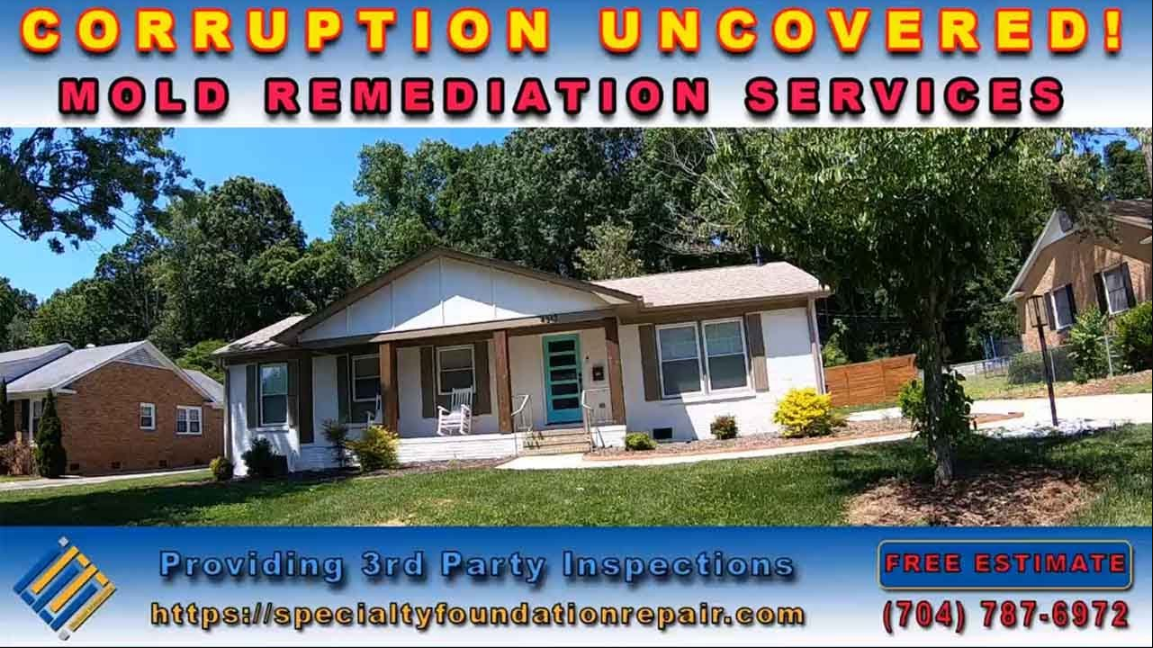Occasionally, you get the opportunity to review the work installed by other companies. A couple weeks ago I got a phone call from one of the real estate agents that I work with quite frequently. She currently owns a property in uptown Charlotte, North Carolina that is used as a rental property. The agent reported that she was dealing with water intrusion coming into the crawlspace, and asked me to investigate the source. She also asked me to review the remediation work that was installed by another company approximately six months ago. The attached video references the inspection, and the numerous flaws noted with the installation.
As the video clearly shows, there are multiple manifestations of mold all around the crawl space. Some of the areas noted around the duct work were never touched. The client was charged $2000 for a mold remediation. Most likely some sort of “fogging” procedure was chosen due to the lack of clearance noted inside the crawl space. You cannot “fog” mold. It must be treated and removed. Also, it is wise to get a licensed 3rd party mold hygienist involved to “clear” the crawl space with luminometer readings after the job is completed. The mold hygienist can also be contracted first to perform testing as well as writing up a protocol for remediation contractors to follow. All mold remediation contactors should be NORMI and/or IICRC certified. Ask to see the licensing credentials when collecting estimates. And never hire contractors that self-clear their work for the obvious reasons.
The second flaw noted was right at the crawlspace door. The Crawlspace well is in a deteriorated state, and requires significant repair in order to keep water from coming into the crawlspace. Based on the sediment stains noted on top of the liner, most of the water intrusion is coming in from under the door and migrating across the crawlspace pooling at the left front corner of the crawlspace. A simple modified crawlspace well can be installed with either cinderblock and/or timber perimeter walls. The area directly in front of the door must be excavated out down below the grade of the door entry with 4 inches of gravel being added at the base of the well to allow water to seep back into the ground before it enters the crawlspace. Also, all downspout discharges should be extended with 6 ft. gutter extensions. The discharge at the left front corner should have a 10ft. extension installed to get the water completely outside the flower bed. As a last resort, the liner can be pulled out, and a network of 4″ foundation drains with commercial sump pump installed along the curtain wall as needed to remediate potential water intrusion challenges.
It appears that a 10-mil fiber reinforced liner was installed over the crawl space soils. Keep in mind this is not a full encapsulation. The liner is not mechanically fastened to the piers and/or crawl space curtain wall. The liner is taped, and the vents are closed off and sealed from the inside the crawlspace with foam board and expandable foam. A commercial dehumidifier was also installed about 10 feet from the crawlspace door. The unit was set at 40% relative humidity and a 25-foot duct kit was installed on the unit to re-direct the exhaust towards the front of the crawl space. Duct kits are often seen on many installations. They reduce the effectiveness of the dehumidifier. The longer the duct kit, the less effective the airflow becomes. Dehumidifiers are not designed to move air very well inside crawlspaces. The tighter the crawlspace, the more challenging the airflow becomes. In this case, the duct kit should be removed, and the unit repositioned at the center of the crawl space. Due to the many dead pockets of air movement noted inside the space around the duct work, a series of Amox dead corner fans should be deployed to help the dehumidifier distribute air around the entire space. This will improve dehumidifier efficiencies as well as preserving the lifespan of the dehumidifier by many years. Also, the RH setting should be bumped to 65% for long term use.
You can also see that much of the duct work was damaged during the installation at multiple locations. And the damage was not reported to the client. So now the crawl space has multiple duct leaks reducing efficiencies as well as changing the temperature and dew point inside the crawl space. Any company performing crawl space type repairs should have the ability to repair and re-route duct work as needed during the project. Sometimes bringing in a 3rd party HVAC contractor after the project is recommended to perform an inspection of the entire system and expedite any/all needed repairs.
It is important to understand that not all crawl space encapsulation and/or mold remediation companies are equal. And there are too many of them now in the marketplace. Be sure to do proper research. Ask for references and proper credentials especially when cleaning mold. And always consider having 3rd party oversight by a qualified professional to inspect the work once it is completed. For more information about crawl space encapsulations, mold remediations, and/or water intrusion and moisture issues please feel free to give us a call for an independent evaluation. We are here to help!

